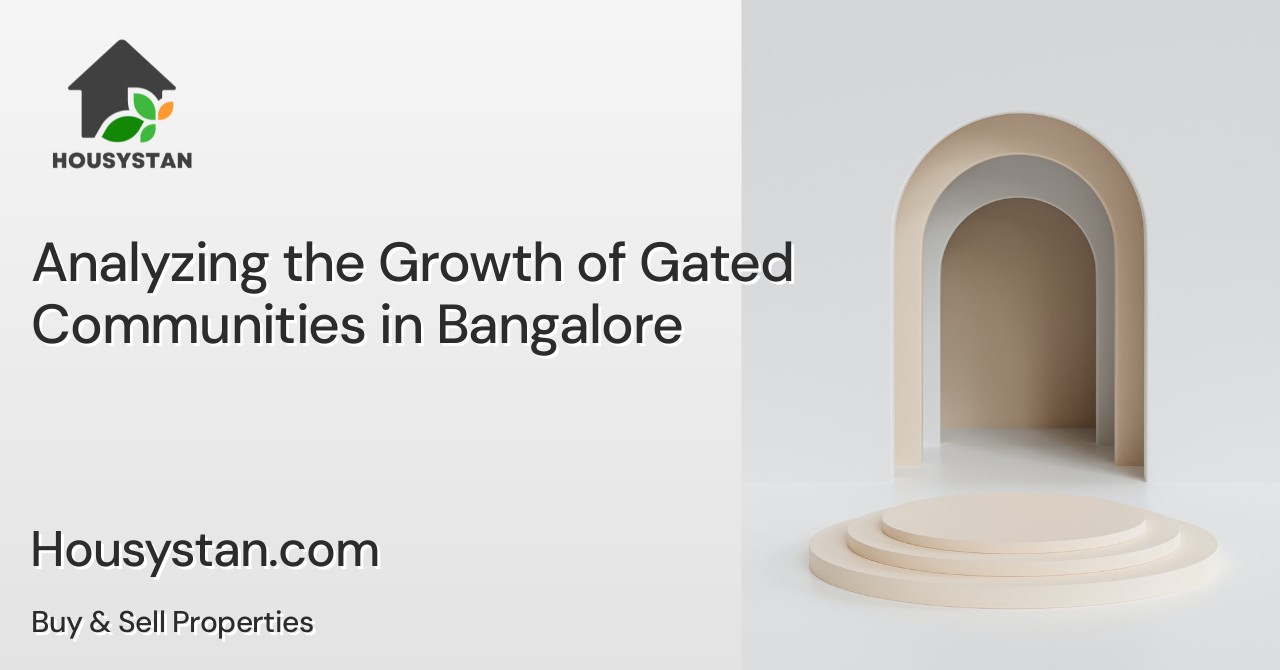Analyzing the Growth of Gated Communities in Bangalore
Read latest blogs and articles from Housystan

The Information mentioned here was last updated on:
9/1/2026Analyzing the Growth of Gated Communities in Bangalore
Bangalore, known as the Silicon Valley of India, has experienced remarkable growth over the past few decades. As the city expanded, so did the need for housing. Among the various housing options, gated communities have emerged as a popular choice for many Bangaloreans. Let’s delve into the factors influencing the rise of gated communities in Bangalore, exploring their appeal, and understanding their impact on the city’s housing landscape.
The Rise of Gated Communities: A Brief Overview
- Verified Tenants/Buyers
- Unlimited Property Listing
- Zero subscription/charges fee
Gated communities first appeared in the United States in the mid-20th century and have since spread across the world. In India, especially in growing urban centers like Bangalore, such communities have been on the rise since the late 1990s. These developments often feature a collection of homes surrounded by a perimeter wall or fence, with controlled access points for residents and guests.
The appeal of gated communities traverses different demographics, from young professionals seeking convenience to families desiring safety and security. This configuration offers a unique lifestyle package that has become increasingly desirable as Bangalore continues to urbanize and industrialize.
Factors Driving the Popularity of Gated Communities
Security and Safety
One of the most notable reasons for the growth of gated communities in Bangalore is the promise of enhanced security. These communities typically boast 24/7 security personnel, surveillance cameras, and controlled access points, providing residents with a sense of safety not always available in traditional neighborhoods. In a bustling city like Bangalore, where privacy and security concerns can be significant, this assurance is a key factor in the growing preference for gated living.
Access to Amenities
Gated communities in Bangalore often come equipped with a wide range of amenities, including swimming pools, gyms, parks, and clubhouses. This all-in-one offering appeals to families and individuals seeking convenience and leisure activities within close proximity to their homes. The modern urban lifestyle increasingly values time, making the presence of such amenities a considerable boon.
Infrastructure and Urban Planning
Bangalore's rapid expansion and its position as a tech hub have led to considerable strain on public infrastructure. Traffic congestion, pollution, and inadequate public services are common urban challenges. Gated communities often offer their own infrastructure solutions, such as private water supply systems, efficient waste management, and well-planned roadways, providing relief from the inefficiencies that plague other parts of the city.
Economic and Social Implications
Impact on Real Estate Market
The surge in popularity of gated communities has had a significant impact on Bangalore’s real estate market. These exclusive enclaves often attract higher property values due to the perceived quality of life associated with them. This, in turn, has led to increased investment from both domestic and foreign buyers, further boosting the local economy.
Socio-Cultural Aspects
While gated communities are sought after for their privacy and security, they can also lead to a sense of exclusivity, sometimes creating barriers between different societal groups. The physical separation from the surrounding city might limit interactions among residents and their non-gated neighbors, affecting the social fabric of Bangalore.
Environmental Considerations
Sustainable Development
With increasing awareness of environmental issues, many gated communities in Bangalore are now focusing on sustainable development practices. These include rainwater harvesting systems, solar energy implementations, and eco-friendly building materials. Developers recognize that environmentally conscious features not only reduce the community’s carbon footprint but also attract eco-minded buyers looking for responsible living options.
Green Spaces
Bangalore, once known as the "Garden City," is seeing a revival of green spaces within these gated communities. Lush gardens and green belts are integrated into the designs, offering residents the benefits of cleaner air and the therapeutic effects of nature, contributing positively to both mental and physical well-being.
Changing Lifestyle Preferences
Flexibility and Modern Living
The shift towards gated communities reflects a broader change in housing preferences. Modern lifestyles demand flexibility and convenience, which gated communities are well-equipped to provide. Smart homes, energy-efficient designs, and contemporary architecture appeal to young professionals and families looking to balance work with recreation effortlessly.
Work-Life Balance
The work-from-home trend, which accelerated due to the COVID-19 pandemic, has further fueled demand for homes that support a balanced lifestyle. The privacy and tranquility of gated communities provide an ideal environment for remote working, with home offices becoming a common feature.
Challenges and Criticisms
Affordability and Accessibility
While gated communities offer numerous advantages, they are often beyond the financial reach of many. The premium on such properties limits access, making it a luxury option rather than a feasible solution for middle or low-income families, which could widen the socio-economic gap in urban settings like Bangalore.
Homogeneity Concerns
Critics point out that gated communities may lack diversity, leading to homogenized living environments. This can stifle cultural and social diversity, potentially leading to communities that are less representative of the broader population.
Future Prospects
Technological Advancements
As technology continues to play a crucial role in urban development, gated communities in Bangalore are poised to evolve with smart technologies, from automated security systems to AI-powered management solutions, enhancing convenience and efficiency for residents.
Policy and Regulation
Urban planners and policymakers must consider the implications of gated communities on urban development and integrate them into the broader regional planning efforts. Balanced regulations can ensure that these communities contribute positively to the city’s growth while addressing concerns like social equality and environmental sustainability.
Gated communities in Bangalore encapsulate the evolving needs and desires of urban inhabitants, providing safety, community, and convenience within the hectic pace of city life. As more people gravitate towards such modern living arrangements, examining the effects and future of gated communities will remain critical. Understanding these dynamics helps illuminate the intricate layers of urban growth in Bangalore and how they shape the life of its residents.